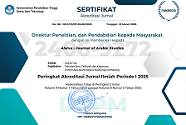Istikhdām Lu‘bah Thu‘bān wa Sullam li Tarqiyyati Raghbati Ta‘allumi al-Qiraati wa Injāzihi fi al-Madrasati al-Mutawāsiṭati
DOI:
https://doi.org/10.21580/alsina.2.2.4215Keywords:
Permainan ular tangga, learning desire, learning achievement, reading skillAbstract
This research aims to calculate the pupils’ desire and achievement in learning to read among those who use the snake and ladder game and those who do not use it in Madrasah Tsanawiyah Negeri 1 Kudus for the academic year 2019-2020. Based on the number of students in the school, we preferred two classes, the eighth - a experimental group, and the eighth - b as a control group for the purpose of experimental research. The methods used to collect data are observation, interview, documentation, questionnaire, and testing. The results of this research indicated that teaching reading skill using this game is better than without it, so that the average grade for the experimental semester is 85.69 and the average grade for the control class is 79.72. To test the hypothesis, I got t calculation = 5,209 compared to -table t = 1,9944. The mean is higher in the experimental group than in the control group. This means that there is a big difference in learning to read after and without using this game. As for the result of the questionnaire, it indicated that the desire to read using this game is 55% to 92.75%, an increase of 37.75%, and the researcher is sure that the result is high between the pre and post test. It can be concluded that using the game Ular Tangga is suitable for promoting students' desire and achievement in learning to read.
Downloads
References
طه علي حسين الدليمي و سعاد عبد الكريم عباس الوائلي,اللغة العربية مناهجها وطرائق تدريسها.
Acep Hermawan, Metodologi Pebelajaran Bahasa Arab, Bandung: Remaja Rosdakarya, 2014.
Agus N Cahyo, Game Khusus Penyeimbang Otak Kanan dan Kiri Anak, Jogjakarta: FlashBooks, 2011.
Azhar Arsyad, Media Pembelajaran, (Jakarta: PT. Raja Grafindo Persada,2013).
Dalman, Keterampilan Membaca , Jakarta: Raga Grafindo Persada, 2014.
Dalyono, Psikologi Pendidikan, Jakarta:Rineka Cipta, 2009.
Naifah, Evaluasi Pembelajaran Bahasa Arab, Semarang: CV Karya Abadi Jaya, 2015.
Purwanto, Evaluasi Hasil Belajar(Pustaka pelajar: Yogyakar-ta, 2009.
Rika Paduri L.Gaol,”Perancangan Dan pembuatan Game Ular Tangga Menggunakan Visual Basic,Tugas Akhir,(Medan:Fakultas Matematika,2011),Universitas Sumatera Utara
Slameto, Belajar dan Faktor-faktor yang mempengaruhinya, Jakarta: Rineka Cipta, 2010.
Sugiyono,Metode Penelitian Kuantitatif Kualitatif dan R & D, Bandung:Alfabeta, 2009.
Suharsini Arikunto, Prosedur Penelitian Suatu Pendekatan Praktik, Jakarta: Rineka Cipta, 2006.
Downloads
Published
How to Cite
Issue
Section
License
Copyright
The copyright of the received article shall be assigned to the publisher of the journal. The intended copyright includes the right to publish the article in various forms (including reprints). The journal maintains the publishing rights to published articles. Authors are allowed to use their articles for any legal purposes deemed necessary without written permission from the journal, but with an acknowledgment to this journal of initial publication.
Licensing
In order for Alsina: Journal of Arabic Studies to publish and distribute research articles, the editors need publishing rights (transferred from author to publisher). This agreement relates to the transfer/publishing copyright license to Alsina: Journal of Arabic Studies but the authors still have significant rights to use and share their published articles.
Alsina: Journal of Arabic Studies supports the need for writers to share, disseminate and maximize the impact of their research and their rights on any database. As a journal article writer, you have the right to various uses of your articles, including that by the institution or company where you work. Copyright can be used without the need for special permission. Authors who publish articles in the Alsina: Journal of Arabic Studies have broad rights to use their work for teaching and scientific purposes without requesting permission, including:
- Use by the author for lectures, presentations, or conferences, with distribution of copies to participants;
- Distribution to colleagues for research use;
- Use in compilations of the author's subsequent work;
- inclusion in a thesis or dissertation;
- Reuse of sections or excerpts from articles in other works (with full acknowledgment of the final article);
- Preparation of derivative works (other than commercial purposes) (with full acknowledgment of the final article);
- Voluntary posting on open websites operated by authors’ or writers' agencies for scientific purposes
When submitting a manuscript, authors do so on the understanding that if accepted for publication, the copyright for publishing (publishing right) of the article shall be assigned/transferred to Alsina: Journal of Arabic Studies.
Authors whose articles are accepted for publication will receive confirmation via email and sent a Copyright Transfer Agreement.


 Accreditation
Accreditation 
 In Collaboration with
In Collaboration with 

 Visitors
Visitors  Article Template
Article Template





